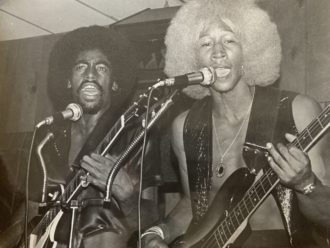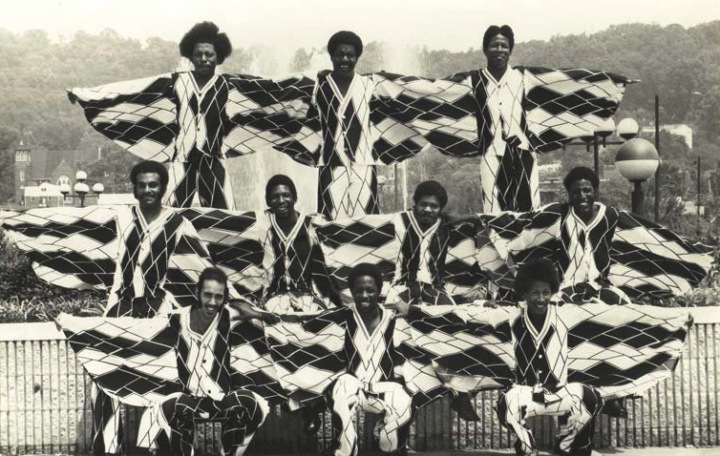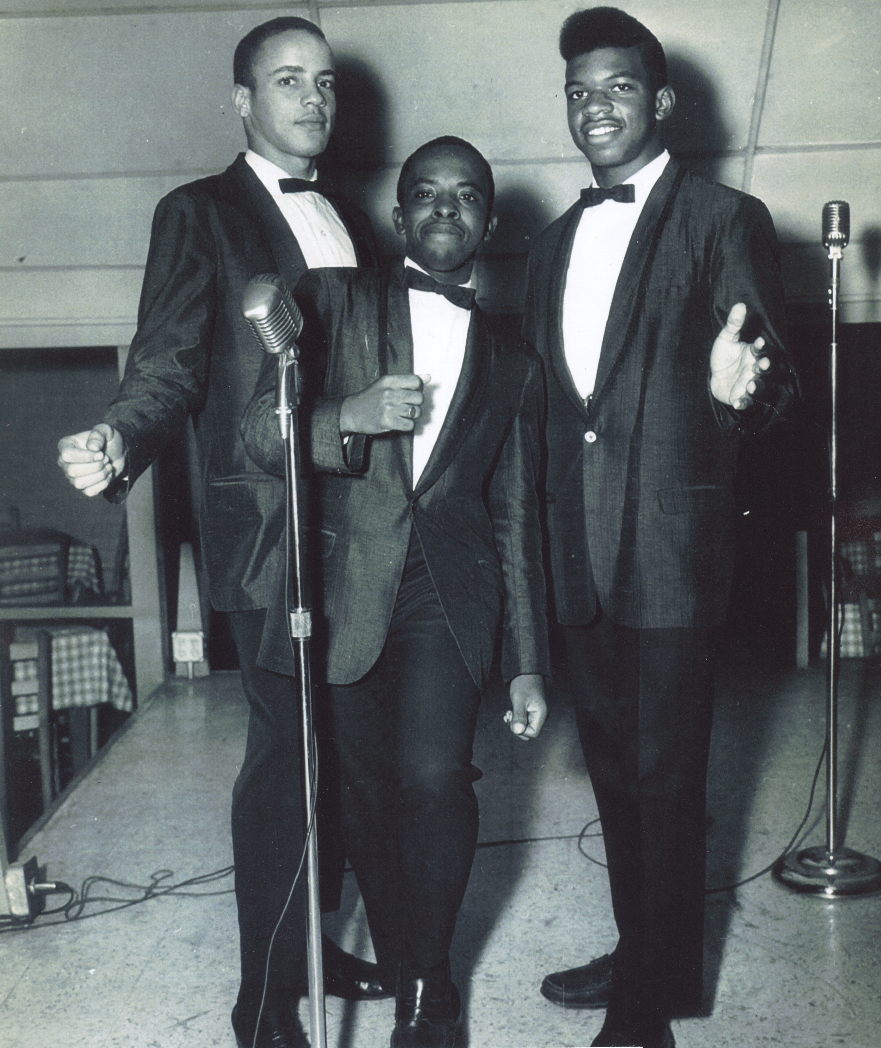The Orange Peel has earned a reputation as one of the premier concert venues in the Southeast over the past two decades. But the musical roots of the building at 101 Biltmore Ave. stretch back to long before the current club opened in 2002.
For a period in the 1960s and another in the 1970s, the spot was home to Black music clubs that brought top national and regional acts to town and helped showcase dazzling homegrown R&B talent. Whether it was the soulful Jade Club, starting in 1965, or the funky Orange Peel, starting in 1974, the building was the place to be for young African Americans looking to don their finest, flashiest clothes and dance a weekend night away.
“It was electric,” says Asheville’s J.C. Martin, who performed regularly at the original Orange Peel as the bassist of two funk bands. “The dance floor would be packed. And people would be dressed up. Our people, you see, they dressed in big hats and loud suits back then.”
Adds Jim Robinson, who deejayed many shows at the club in the 1970s: “You did not walk in that front door if you did not dress. You had to dress to impress.”
Both clubs eventually closed. And the once-bustling Black business district near the building disappeared amid urban renewal in the 1960s and ’70s that dramatically reshaped Asheville’s neighborhoods. But those who remember the glory days — along with those who run The Orange Peel today — are determined to keep the site’s Black music legacy alive.
Both James Brown (no, not that one) of Fletcher, who sang at The Jade Club as a teenager, and Martin have folders full of photos and press clippings they eagerly share with those who are interested in the venue’s musical heritage. Robb McAdams, The Orange Peel’s assistant marketing manager, headed up efforts a few years ago to create a permanent exhibit in the club’s front gallery telling the building’s history from its 1946 construction to the present day.
“Everything two miles that way and everything two miles this way was an affluent Black community in the ’50s and ’60s, and by 1980, it was gone,” says McAdams, pointing out to Biltmore Avenue from inside the club. “That’s why we try to do things like this when we can. The name we’re using is the name they used back then [in the 1970s]. We want to pay homage to that and pay homage to the Black history that is slipping by in Asheville.”
But McAdams and others trying to preserve the history find it isn’t always easy. Key figures from those days, including the club owners and many of the musicians who played there, have died. Faulty memories and spotty newspaper coverage mean that important details — for instance, exactly when each club closed — remain elusive. Chronologies often don’t line up, and some firsthand accounts don’t check out.
“This is our best effort to get it right, but we’re not historians,” McAdams says. “Someone maybe can jump in from where we left off.”
The Jade Club: 1965-69
Stax recording star Rufus Thomas was the headliner when the Jade Club opened on Dec. 17, 1965, in a building that had housed a skating rink and a bowling alley. Thomas sang his 1963 hit, “Walking the Dog,” along with a selection of other songs.
“The South’s Finest Colored Club,” as it was billed by owner Jake Rusher, soon became one of the area’s favorite spots for young African Americans — and more than a few white people — looking for a night of music and dancing until 2 a.m.
“It was something that people looked forward to on the weekend,” says Brown, who sang at the club as a member of a vocal trio called the Royal Primes. “You would check the paper on Wednesday, Thursday, Friday, to see who’s going to be there. The stars would come in, and people would just have a good time.”
And what stars they were. From 1965-68, a virtual who’s who of the day’s top R&B performers appeared at 101 Biltmore Ave.: Sam & Dave, Percy Sledge, The Drifters, The Dixie Cups, Arthur Conley, Eddie Floyd, The Shirelles, Jerry Butler, Clarence Carter, James Carr. Future country star Ronnie Milsap, then an R&B performer known as “the white Ray Charles,” performed at the club, as did a teenage Peabo Bryson, singer for a Greenville, S.C., band led by Moses Dillard.
Scores of local and regional acts took the stage as well.
“The Jade Club was the real historic music spot in Asheville in the 1960s,” says David Penley, who grew up in that era and offers the Historic Music Scene walking tour. “I find it somewhat amusing that most folks do not even mention the Jade Club when talking about the history of The Orange Peel.”
McAdams thinks the ’70s iteration of The Orange Peel gets more attention because the current club adopted its name.
“Some of that legendary [Jade Club] history got mentally rolled into The Orange Peel,” he says. “But it really seemed like Jade Club was the missing piece of the puzzle when we were putting the exhibit together.”
Brown, the last living member of the Royal Primes, wants to make sure that era is not forgotten. He helped McAdams piece together the Jade Club’s section in the exhibition and has kept many photos and other keepsakes from his time at the club.
The Royal Primes consisted of Brown, his cousin James Beasley and Stumptown neighborhood friend Larry Rice. The group made its debut at the club on Dec. 13, 1966, singing along to music provided by the Centurians, a local integrated four-piece band. Over the next year or so, the Centurians and Royal Primes served as the house band. Sometimes they headlined dance parties, and other times they opened for national acts like Milsap, the Ovations or Garnet Mimms.
“I was young, I was 15 years old,” Brown says. “In fact, we were so young, when we weren’t singing, we were supposed to stay in the dressing room because they had a bar. But that didn’t last long. After a while, we just became part of the fixtures there.”
The Royal Primes sang hits by the likes of Sam & Dave, The Temptations, The Impressions and, of course, Brown’s more famous namesake, the Godfather of Soul himself. He remembers belting out “Papa’s Got a Brand New Bag” and “Cold Sweat.”
Club owner Rusher was a white businessman who also owned The Pines, a popular music venue that was part of his 8-acre Royal Pines recreation area on the south end of Sweeten Creek Road.
“That was where most of your white students, the college students, hung out,” Brown explains. “The Jade Club was mainly where you had the Black community.” While it was not unusual to see some white faces in the Jade Club audience, Brown recalls, Black people never attended shows at The Pines.
Joe Miller was the talent booker for both clubs, Brown says.
“Joe Miller was one of them flamboyant-type people,” recalls Martin, who played at the club. “They used to nail posters [for upcoming Jade Club shows] up on the post on every corner in the neighborhood and put them up in the businesses.”
Miller would frequently book an act at The Pines and the Jade Club on back-to-back nights. For instance, Percy Sledge, less than a year removed from his No. 1 hit “When a Man Loves a Woman,” appeared at The Pines on Saturday, Feb. 18, 1967, and the Jade Club the following night.
The club kept operating through the fall of 1968, but things get murky at that point.
An October 1968 ad in the Citizen-Times promoted “Soul Nite” with headliner Eddie Floyd. The next time the Jade Club was mentioned in the paper was March 1969, when Gene Chandler (of “Duke of Earl” fame) and other artists appeared at the “Grand Re-Opening.” From May through July of that year, however, several newspaper ads refer to 101 Biltmore Ave. as the Country Palace. On June 23, rock ‘n’ roll pioneer Jerry Lee Lewis, then a country star, appeared at the club, one night after he performed on a bill with Merle Haggard at the City Auditorium (now the Thomas Wolfe Auditorium).
According to newspaper records, the spot at 101 Biltmore Ave. was home to the New Thing Coffee House starting in November 1971. In June 1973, it was a youth employment center operated by the State Employment Security Commission and the Neighborhood Youth Center.
By that time, the Royal Primes were long gone.
“Vietnam broke us up,” Brown says. “We was all drafted. Went in at different times. Then we came out, and we never got back together.”

The Orange Peel: 1974-78
Music returned to 101 Biltmore Ave. on Feb. 10, 1974, with the opening of the original Orange Peel. Five years or so had passed since the demise of the Jade Club, and music and fashion had changed. The new club had a DJ booth, held disco nights and featured funk bands with flashy costumes, elaborate light shows and towering Afros. It was all a far cry from the comparatively buttoned-down R&B scene of the mid-to-late ’60s.
“The dance floor is usually crowded with young people doing ‘The Bump’ or ‘The Hustle,’ a form of dance that’s popular among young people,” the Asheville Times reported in 1975.
The Orange Peel was the brainchild of Dick “Dickie” Plemmons, a former stock-car racer who later ran a rug-manufacturing business in South Asheville. Plemmons co-owned the club with Asheville businessman John Sronce, who owned the building.
The story of the club’s origin is a little fuzzy, but it appears Plemmons was looking for a place to showcase the Innersouls, a six-piece Asheville band he started managing after hearing the group play at the Kitty Kat Club, another Biltmore Avenue R&B spot. Plemmons financed and produced the group’s lone 45 in 1973, “Just Take Your Time.”
“We were serious about our music,” says Asheville’s Samuel Bowman, one of the band’s guitarists. “We ain’t never took it lightly.”
But after a time as house band at the club, the Innersouls disbanded due to internal disagreements. Group leader Otis Ware soon put together a new band that included himself and fellow Innersouls veterans Martin and trumpet player Leroy Posey. Seven other top musicians were added, including five from outside Asheville.
The band was called Bite, Chew & Spit. The name, modeled after Earth, Wind & Fire, came from something Plemmons said when he was attempting to learn how to chew tobacco: “Damn — all I do is bite, chew and spit this s**t!”
BCS was pure mid-1970s funk, right down to its sizzling horn section and flowing black-and- white outfits with sleeves that looked like wings. When the members weren’t on tour, they were performing before large crowds on the club’s carpeted, three-tiered stage. “Every one of the guys in that organization was professional,” recalls Robinson. “As musicians, they were absolutely top-notch.”
This Asheville Times’ description of the band’s debut performance in September 1975 gives a flavor of that long-gone era: “Young music lovers stood spellbound at the edge of the bandstand as the BCS went through three hours of showmanship, using firetruck lights, sirens and CO2. BCS members also changed costumes three times during the show.”
BCS’ large repertoire included the Ohio Players’ “Fire,” Earth, Wind & Fire’s “Getaway” and Hall & Oates’ “Sara Smile.”
“We used to have to walk through the folks, from the dressing room in the back to the front, where the stage was,” Martin remembers. “This was the fun part. The dance floor would be packed, and they treated you like you was pretty much a celebrity.”

Aside from BCS, The Orange Peel featured performances from regional bands from Greensboro, Richmond, Va., Atlanta, Winston-Salem and other places. It also brought in national acts like Archie Bell & The Drells, the Manhattans and the Chi-Lites. Probably the best-known act to perform at the club was the Commodores, including singer Lionel Richie, who took the stage in July 1974, shortly after the release of its debut Motown single “Machine Gun.”
“The Orange Peel is basically where the Commodores got started,” says Robinson, who deejayed at that July 1974 show. Bowman and Martin even recall Plemmons selling the Innersouls’ equipment to the Commodores after the Asheville band broke up.
Between sets and on weekend nights when bands weren’t playing, The Orange Peel featured music from Robinson (billed as “Little Jimmy Robinson”) and other DJs at WBMU, Asheville’s first nonprofit radio station and one of only a handful in the country that was Black-owned. Another popular DJ was Cleo “Mooseman” Shivers, famous for his fade-out “Orange Peel-Peel-Peel-Peel” routine.
“I started at The Orange Peel when Dick first started the club,” says Robinson, who was president and general manager of WBMU. “I was the house DJ, and we built a DJ booth in the corner, up high, with four steps going up into the booth and a little door so nobody else could come up in. Friday and Saturday night, we just got down. A lot of partying. A lot of dancing.”
Martin says the club often functioned as something like a community center for Asheville’s Black population.
“Even the children was watching their parents, and they was longing for the day when they got old enough to go to The Orange Peel,” he says. “They tell me that even now [as adults] all of the time: ‘I wish I had been able to go.'”
But the club didn’t last long enough for that.
Just as with the Jade Club, it is hard to pinpoint the exact ending date of the original Orange Peel. The last Citizen-Times ad for a show at the club was in November 1978. A November 1979 article in the paper said a temporary office for the 1980 U.S. census was set to open at 101 Biltmore Ave., “formerly the Orange Peel club.”
Like so many other Black clubs that once thrived in Asheville — the Kitty Kat, the Owl Lounge, the Cage, the Collegiate Club — The Orange Peel was no more.
For most of the next two decades, the building stood vacant. After a stint as an auto parts warehouse, The Orange Peel was reborn in 2002 as part of an initiative by Public Interest Projects Inc., a downtown development group that wanted it to once again become a music venue.
Since it reopened, The Orange Peel has helped put Asheville on the musical map by bringing in big names like Bob Dylan, Ice Cube, Lou Reed and the Beastie Boys. The Foo Fighters’ Dave Grohl sung the club’s praises in the pages of Rolling Stone. Alt rock superstars the Smashing Pumpkins made national headlines by playing a nine-show residency in 2007, the band’s first U.S. shows in seven years.
“You can go to The Orange Peel and see everybody in the world now,” Martin says. “The Smashing Pumpkins, they came all the way from Europe and they didn’t want to play but a few places in the United States, and The Orange Peel was one of them.”
“It’s international now,” adds Bowman, the one-time Innersouls guitarist.
“Yeah,” Martin agrees. “And we’re the ones that built The Orange Peel.”
Editor’s note: This story was updated on March 13 to accurately reflect Public Interest Project Inc.’s role in the re-opening of the club.



I did a lot of skating there in the 1950’s when in Grace School it was trendy for students to have skating birthday parties and invite their whole class.. I’d forgotten the “Jade Club” name but in the mid 60’s I do remember attending “The Shirrells” concert. My buddy and I took our dates to dinner at the Red Carpet Room at Buck’s before the concert. We definitely did not wear shorts or jeans OR coat and tie. Our dress would now be called “business casual” .. Although the Shirrells were definitely black, in the mid 60’s Asheville was not very “advanced” in the integration realm. I definitely do not think that the Jade was a predominately black club other than the talent back then.